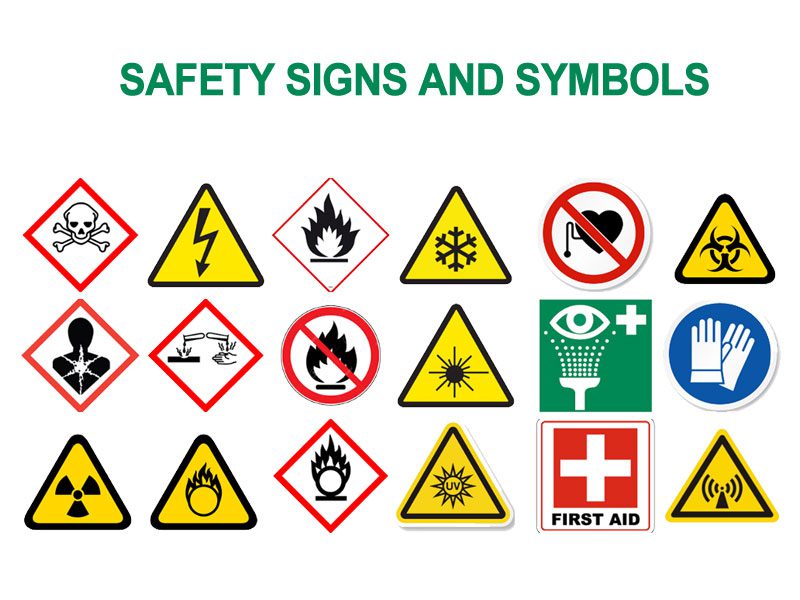Every day, countless workers across diverse industries navigate environments with varying degrees of risk. From construction sites bustling with heavy machinery to quiet laboratories filled with intricate equipment, one element plays a crucial role in safeguarding their well-being: safety signs. These seemingly simple visual cues act as silent guardians, constantly vigilant in their mission to prevent accidents and promote a safe working culture.
But not all safety signs are created equal. Each symbol, color, and word conveys a specific message, urging a particular action or warning of potential hazards. Understanding these different types of signs is vital for both employers and employees, ensuring clear communication and adherence to crucial safety protocols.
Let’s delve into the world of workplace safety signs and explore their essential categories:
1. Prohibition Signs:
These instantly recognizable red circles with diagonal white lines scream STOP! Prohibition signs communicate actions that are strictly prohibited in a specific area. They typically depict an image of the forbidden activity, like “No Open Flames” or “No Smoking,” leaving no room for ambiguity. Their purpose is to prevent accidents before they happen by clearly outlining what should not be done.
2. Mandatory Signs:
In vivid blue backgrounds with white symbols or text, mandatory signs instruct workers on actions they must take in specific areas. These include reminders to “Wear Eye Protection” or “Use Handrails,” ensuring essential safety measures are consistently followed. Compliance with these signs plays a critical role in mitigating risks and protecting individuals from harm.
3. Warning Signs:
Yellow triangles with black symbols or text paint a picture of caution. Warning signs alert workers to potential hazards present in the environment. From “Wet Floor” warnings to “High Voltage” alerts, these signs raise awareness and prompt workers to proceed with vigilance and take necessary precautions to avoid accidents.
4. Emergency Signs:
In bright green backgrounds with white symbols or text, emergency signs guide workers during unforeseen situations. They point the way to “Fire Exits” and “First Aid Kits,” providing crucial navigational aids in times of crisis. Their clear visuals and readily understandable symbols ensure effective response even in moments of panic, leading individuals to essential resources and facilitating swift action.
5. Fire Safety Signs:
Fire presents a unique and potentially devastating threat in many workplaces. Red backgrounds with white symbols or text mark Fire Safety signs, highlighting crucial equipment and information in such scenarios. From “Fire Alarm” locations to “Fire Hose” connections, these signs ensure quick identification and proper utilization of vital tools for fire suppression and evacuation.
Beyond Color and Symbol:
While color and symbol combinations are the backbone of safety sign classification, additional elements sometimes come into play:
- Wordings: Specific instructions or hazard descriptions may accompany symbols for enhanced clarity. For example, a “Confined Space – Entry Permit Required” sign leaves no room for misinterpretation.
- Pictograms: Sometimes, images alone replace text, catering to non-English speakers or visually-impaired individuals. A pictogram of a person tripping on a wet floor is universally understood, transcending language barriers.
- Illumination: In low-light environments, reflective or luminescent features may be incorporated to ensure signs remain visible even in the dark.
Choosing the Right Signs:
Selecting the appropriate types and configurations of safety signs for your workplace is crucial. Factors like industry, potential hazards, language diversity, and lighting conditions all need to be considered. Consulting with relevant safety authorities and involving employees in the selection process can further enhance effectiveness.
Beyond the Sign Itself:
Remember, safety signs are only the first step. Proper installation, regular maintenance, and ongoing training on sign interpretation are equally important. Educating employees on the different types of signs and their meanings ensures they can decipher the silent messages effectively and respond appropriately to potential threats.
Conclusion:
In the symphony of workplace safety, signs play a vital melody. Each color, symbol, and word contributes to a harmonious rhythm of awareness, precaution, and proactive action. By understanding the different types of safety signs and utilizing them effectively, we can collectively ensure that every workplace becomes a safer haven for everyone.
So, the next time you encounter a safety sign, don’t simply glance and move on. Take a moment to appreciate its silent message, the guardian angel watching over your well-being. Remember, these visual cues are not mere decorations; they are vital tools in the ongoing pursuit of a safer and healthier work environment for all.


